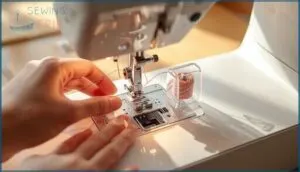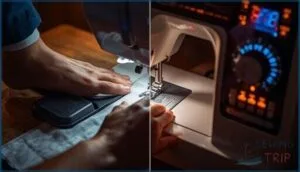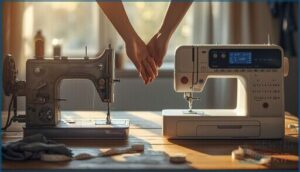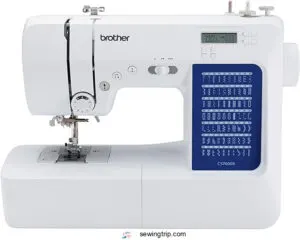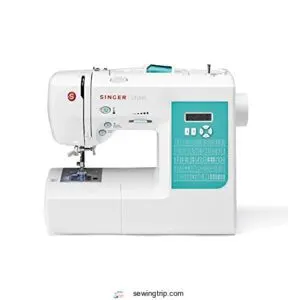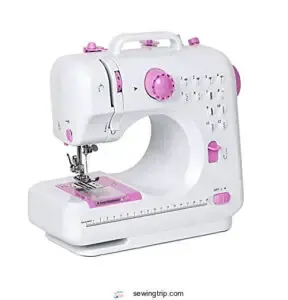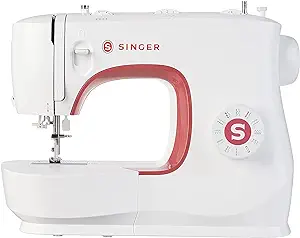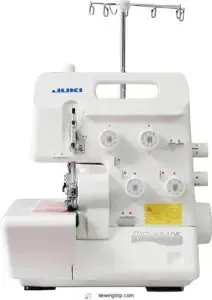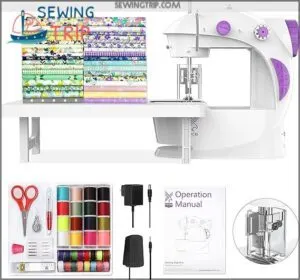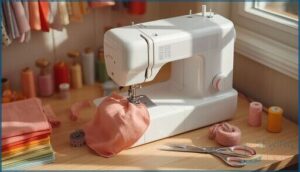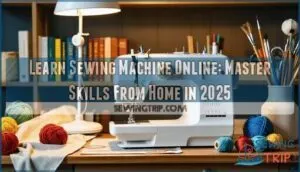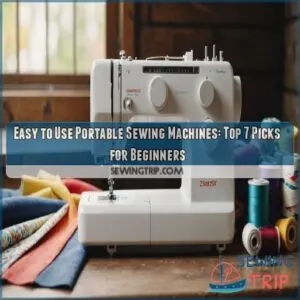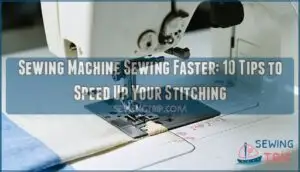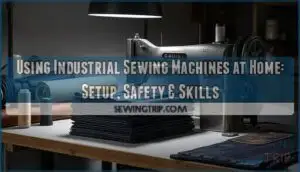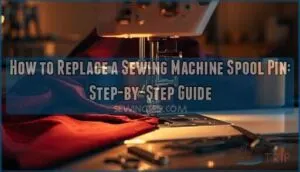This site is supported by our readers. We may earn a commission, at no cost to you, if you purchase through links.
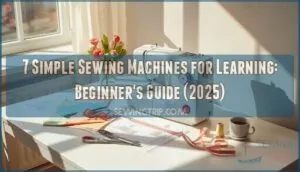
Your first sewing project shouldn’t feel like decoding a spaceship manual. Many beginners abandon sewing within weeks because they choose machines loaded with features they’ll never use, or worse, machines so bare-bones they can’t handle basic tasks.
The sweet spot exists in what sewing instructors call a simple sewing machine for learning—one that offers essential stitches and helpful automation without overwhelming you with buttons, menus, and complicated settings. These machines let you focus on developing good technique rather than fighting with technology.
Finding the right balance between capability and ease of use can mean the difference between a frustrating first experience and building skills that last a lifetime.
Table Of Contents
Key Takeaways
- Your first sewing machine should balance essential features like automatic threading and drop-in bobbins with simplicity—machines with 20-100 stitches are plenty, as most beginners use straight stitch, zigzag, and buttonhole functions 99% of the time.
- Mechanical machines cost less and teach fundamentals through hands-on control, while computerized models reduce frustration with automatic threading and built-in guidance, making them worth the extra cost if your budget allows.
- Start with simple projects like tote bags, pillowcases, or scrunchies on scrap fabric first—this practice reduces mistakes by 65% and builds confidence before you tackle your actual project material.
- Regular maintenance matters more than fancy features: brush out lint after each project, replace needles every eight hours of sewing, and skip machines with over 100 stitch patterns or speeds above 1,000 stitches per minute that cause more problems than they solve.
Key Features of Beginner Sewing Machines
When you’re just starting out, the right sewing machine can make all the difference between feeling confident and feeling completely lost. You don’t need fancy bells and whistles, but there are a handful of features that’ll help you learn without the frustration.
The right sewing machine transforms your learning experience from frustrating confusion to confident creativity
Let’s look at what actually matters when you’re choosing your first machine.
Essential Built-in Stitches for Learners
Your beginner sewing machine doesn’t need hundreds of stitches to get started. Most machines offer straight stitch uses for seams, zigzag stitch benefits for edges, and buttonhole variations for garments. These built-in stitches cover 99% of beginner sewing guide projects. Stretch stitch needs and decorative stitch skills come later, once you’ve mastered the basics.
The straight stitch is essential for seaming and other general tasks. Focus on quality over quantity when comparing sewing machine stitches.
Easy Threading and Bobbin Systems
Once you’ve selected your basic stitches, you’ll need to master getting thread into your machine. Look for an automatic needle threader and drop-in bobbin system—these beginner-friendly features eliminate most threading frustrations.
Drop-in bobbins load from the top, so you can actually see your thread supply. Proper threading is essential, as skipping steps can lead to tension and jams. The tension adjusts easily, and thread management challenges decrease noticeably when you can monitor everything clearly.
Manual Vs. Automatic Speed Control
Your beginner sewing machine speed makes a real difference in your learning curve and stitch consistency. Manual speed control relies on foot pedal pressure, while automatic speed control lets you set a maximum limit.
Machines with automatic needle threader and speed control cost more but reduce errors by 20%, helping you focus on fabric guidance instead of constant pedal modulation. User preference depends on budget and confidence level.
Useful Presser Feet and Accessories
Once you’ve mastered speed control, the right presser feet and accessories will expand what you can create. About 85% of beginners rely on the universal zigzag foot, but specialized options expand your skills:
- Walking foot – prevents fabric shifting on stretchy or layered materials
- Zipper foot – sews close to zipper teeth for clean closures
- Seam rippers – corrects mistakes cleanly, recommended in 70% of tutorials
Extra bobbins, quilting guides, and needle sets also improve your learning experience.
Portable and Lightweight Design
When you’re just starting out, a portable beginner sewing machine simplifies learning and storage. Most weigh 5 to 15 pounds, light enough to move between rooms or take to classes. Compact storage fits small apartments, while cordless options add travel convenience for workshops.
| Feature | Benefit | Typical Specification |
|---|---|---|
| Lightweight Design | Easy to use and transport | 5–15 pounds |
| Compact Storage | Fits tight spaces | Small footprint |
| Cordless Options | Travel convenience anywhere | Battery-powered models |
| Ergonomic Design | Reduces strain during use | Weight impact minimized |
These beginner sewing tips help you choose portable sewing machine features wisely.
Mechanical Vs. Computerized Sewing Machines
Choosing between a mechanical and a computerized sewing machine can feel like picking between two different learning paths. Each type has its own strengths, and understanding the differences will help you decide which one matches your comfort level and goals.
Let’s look at how these machines compare and what makes each option work well for beginners.
Advantages of Mechanical Sewing Machines for Beginners
When you’re first exploring the craft, mechanical sewing machines offer a hands-down advantage through their easy-to-grasp controls and durable metal frames. You’ll save money upfront while building essential skills through manual adjustments. Here’s what makes them ideal for home use:
| Feature | Beginner Benefit | Long-term Value |
|---|---|---|
| Manual dials | Understand stitch mechanics | Master tension control |
| Simple build | Fewer breakdowns | Decades of reliable use |
| Compact size | Easy storage anywhere | Transport to classes |
These beginner sewing machine features focus your learning on fundamentals rather than relying on complex screens.
Benefits of Computerized Models for Learning
While mechanical machines teach fundamentals, a computerized sewing machine transforms your learning experience through smart automation. You’ll appreciate the ease of use for beginners as touchscreens guide each step, reducing your learning curve dramatically.
| Feature | How It Helps You | What You’ll Gain |
|---|---|---|
| Stitch Precision | Automatic length and width settings | Consistent, professional results |
| Time Efficiency | Automatic thread cutting and needle threading | More time practicing actual sewing |
| Customization Options | Digital adjustments for 70+ stitches | Creative freedom without complexity |
| User Convenience | On-screen instructions and troubleshooting | Fewer frustrating moments |
| Speed Control | Adjustable pace with start/stop button | Build confidence gradually |
These beginner sewing machine features let you focus on technique rather than wrestling with manual adjustments.
Combo Features and Multi-function Machines
Think of combo machines as two tools in one toolbox. These sewing and embroidery machine models let you handle basic sewing projects for beginners and decorative embroidery without switching equipment, saving you up to 50% on costs. A beginner sewing machine with embroidery integration offers builtin stitches, tech enhancements like automatic threading, and user convenience features. You’ll enjoy space efficiency while exploring diverse creative possibilities.
| Benefit | What You Get | Why It Matters |
|---|---|---|
| Cost Savings | 30-50% less than buying separately | More budget for fabric and supplies |
| Space Efficiency | 40-60% smaller footprint | Perfect for apartment sewing corners |
| Tech Enhancements | Automatic cutters, USB connectivity | Simplified workflow from day one |
User Interface and Setup Differences
When you compare a mechanical vs computerized machine’s interface design, the setup experience changes dramatically. Mechanical models use physical dials and switches, averaging just 12 minutes for initial setup. Computerized versions feature digital displays and control panels with navigation systems that take 18 minutes, though 92% include automatic threading. Your beginner sewing machine choice affects how quickly you’ll start stitching.
| Interface Type | Setup Time | Key Features |
|---|---|---|
| Mechanical | 12 minutes average | Physical dials, labeled switches |
| Computerized | 18 minutes average | LCD panels, automatic threading |
| Learning Curve | 14% vs 39% need help | Simpler vs more menu options |
Computerized machines have a steeper learning curve, with 39% of users needing help, compared to 14% for mechanical models. This is due to the increased number of menu options and features, such as LCD panels and automatic threading, which can be overwhelming for beginners.
Top 7 Simple Sewing Machines for Learning
Now that you understand the difference between mechanical and computerized models, let’s look at seven beginner-friendly machines that make learning to sew easier.
Each one offers different features and price points, so you can find something that matches your skill level and budget.
These machines range from simple portable options to more capable models that’ll grow with you as your confidence builds.
1. Brother CS7000X Sewing and Quilting Machine
If you’re just starting out, the Brother CS7000X strikes a sweet balance between simplicity and features. With 70 built-in stitches and an LCD interface that shows your settings clearly, you won’t feel lost during projects. Stitch customization is straightforward, adjusting width up to 7mm and length to 5mm.
Weighing just 10.5 pounds, its portability features make it perfect for home use or classes. The quilting benefits include a wide table and walking foot, and beginner sewing machine reviews consistently praise its ease of use—backed by a 25-year warranty for peace of mind.
Best For: Beginners and intermediate sewers who want a versatile, portable machine for sewing, quilting, and creative projects without overwhelming complexity.
- Comes with 70 built-in stitches, 10 presser feet (including a $50 walking foot), and a wide table—everything you need to start quilting or sewing right out of the box.
- Lightweight at 10.5 pounds with a hard case and carry handle, making it easy to take to classes or move around your home.
- Features like the automatic needle threader, LCD display, and adjustable speed control make it beginner-friendly while still offering room to grow your skills.
- Maximum sewing speed of 750 stitches per minute is slower than previous Brother models, which might frustrate users working on large projects.
- Some users report the machine can shimmy or vibrate at higher speeds, and threading certain features may take practice to master.
- Only compatible with standard spools (not cone threads) and designed for 120-volt US outlets, limiting international use and thread options.
2. Singer 7258 Sewing and Quilting Machine
Another solid choice for beginners is the Singer Stylist 7258 Sewing Quilting Machine, offering impressive stitch variety with 100 built-in options. The automatic threading feature saves you frustration, while the speed control slider lets you start slow and build confidence.
Its metal frame provides stability when you’re tackling beginner sewing projects, and the 10 included feet give you room to grow. Weighing about 15 pounds, it’s portable enough for classes yet sturdy for sewing thick fabrics—perfect for beginners ready to expand their skills.
Best For: Beginners who want a reliable, feature-rich machine that can handle everything from basic repairs to creative projects without feeling overwhelming.
- 100 built-in stitches and 10 presser feet give you tons of room to experiment and grow your skills without needing upgrades right away.
- Automatic needle threader and top drop-in bobbin system make setup quick and hassle-free, so you spend more time sewing and less time frustrated.
- Adjustable speed control and metal frame construction let you start slow and steady while handling thicker fabrics like denim with confidence.
- Some plastic components may wear down over time with heavy use, so it’s not built for industrial-level projects.
- The manual might not be included with every purchase, though you can find instructions online if needed.
- Speed settings and power compatibility can vary between machines, which might require some troubleshooting for certain users.
3. NEX Portable Sewing Machine For Children
If you’re searching for a child-safe design with genuine educational value, the NEX Portable Sewing Machine stands out. Its compact build and simple controls make it ideal for beginner sewists, especially children keen to try beginner sewing projects.
You’ll appreciate the portability benefits—lightweight enough for lessons anywhere, yet sturdy for basic tasks like hemming or mending. Project suitability leans toward light fabrics, so it’s perfect for crafts and repairs. Parental supervision is wise, as manual threading and setup require a steady hand.
Best For: Parents looking for a safe, portable first sewing machine to teach children basic stitching skills and simple craft projects.
- Lightweight and compact design makes it easy for kids to transport and store, with both battery and adapter power options for flexibility.
- Simple two-speed control via foot pedal or hand switch helps beginners learn at their own pace, with 12 built-in stitches for variety.
- Affordable entry point for learning basic sewing techniques like hemming and mending on light to medium fabrics.
- Manual threading without an automatic needle threader requires adult help for younger children getting started.
- Not suitable for heavy fabrics or complex projects, limiting what kids can create as they advance.
- Some users report durability concerns with the foot pedal and occasional unclear instructions for true beginners.
4. SINGER MX231 Sewing Machine Portable
For entry-level sewists ready to grow, the SINGER MX231 offers an impressive range. You’ll find 97 stitch applications—far beyond basic straight stitches—plus adjustable settings for width and length, so you can tackle everything from repairs to quilting with confidence.
The built-in needle threader saves frustration, while the front-load bobbin system keeps setup straightforward. User feedback praises its sturdy metal frame and quiet operation, though the manual can feel thin. At around $180, this portable beginner sewing machine balances affordability with room to expand your skills.
Best For: Beginners and hobbyists who want more than basic stitches without jumping to an expensive machine—ideal if you’re ready to experiment with decorative projects, quilting, and garment repairs.
- 97 stitch applications give you tons of creative options beyond straight sewing, all at an entry-level price around $180.
- Built-in needle threader and front-load bobbin make setup quick and less frustrating, especially when you’re still learning.
- Sturdy metal frame keeps things stable and quiet even when you’re sewing faster, so it feels more durable than typical plastic beginner machines.
- The instruction manual is pretty bare-bones, so you’ll likely need to lean on the app or YouTube tutorials to figure things out.
- Struggles with very thick fabrics or multiple heavy layers, so it’s not the best choice if you plan to sew a lot of denim or upholstery.
- Front-load bobbin system can jam if you don’t load it carefully, which adds a small learning curve to an otherwise beginner-friendly machine.
5. JUKI Portable Thread Serger Sewing Machine
Once you’re ready to explore sergers, the JUKI MO654DE shifts your focus from standard stitching to professional seam finishing. This portable serger for beginners accommodates 2/3/4-thread configurations at speeds up to 1,500 stitches per minute, managing light to heavy fabrics without hesitation.
The color-coded JUKI threading guide reduces setup stress, and external dials simplify adjustments for stitch length and differential feed. Serger stitch quality stays consistent thanks to the dedicated knife drive.
Regular serger maintenance tips—like accessing the swing-out panels for lint removal—keep this machine reliable. At around $400, it’s a solid next step for any beginner sewist.
Best For: Beginner to intermediate sewists ready to move beyond basic machines and add professional seam finishing to garments and home decor projects.
- Handles everything from lightweight to heavy fabrics at speeds up to 1,500 stitches per minute, giving you versatility across different project types.
- Color-coded threading system and external adjustment dials make setup and tweaking less intimidating, even if you’re new to sergers.
- Swing-out panels let you clean out lint easily without taking the whole machine apart, so maintenance stays simple.
- Threading can still feel tricky at first despite the color guides—expect a learning curve before it clicks.
- No coverstitch feature, so you’ll need a separate machine if you want that professional hemming option.
- The manual doesn’t cover every stitch variation in detail, so you might need to hunt down online tutorials for advanced techniques.
6. Brother Lightweight Sewing Machine Model
At just 12.6 pounds, the Brother XM2701 Sewing Machine delivers portability benefits you’ll appreciate during your first sewing classes or when working in tight spaces.
This entry-level sewing machine from Brother USA offers 27 built-in stitches with stitch reliability that works with light to medium fabrics smoothly. The easy-to-use design includes an automatic needle threader and jam-resistant drop-in bobbin, making sewing for beginners less intimidating.
Strong market reception and a thorough support package—including a 25-year warranty—demonstrate why it’s a trusted choice among beginner sewing machines.
Best For: Beginner sewers and hobbyists who need a portable, budget-friendly machine for everyday projects like hemming, quilting, and basic garment repairs.
- Lightweight at 12.6 pounds with a built-in handle, making it easy to move between rooms or take to sewing classes.
- 27 built-in stitches and an automatic one-step buttonhole feature give you plenty of options for creative projects without overwhelming complexity.
- Strong value with an automatic needle threader, jam-resistant drop-in bobbin, and a 25-year warranty—all for around $130.
- Some users report skipped stitches and inconsistent stitch quality, especially on thicker fabrics or multiple layers.
- The machine can be noisy when handling heavy materials, which might be distracting during longer sewing sessions.
- Side-loading bobbin is prone to jamming if not inserted correctly, requiring careful attention during setup.
7. KPCB Tech Mini Sewing Machine Set
This Mini Machine Review highlights why the KPCB Tech Mini Sewing Machine Set stands out for learning to sew. Weighing less than three pounds with Portable Design Benefits, it’s perfect for children and adults exploring entry-level sewing machines.
The extensive Sewing Kit Contents includes 32 bobbins, scissors, fabric squares, and a beginner-friendly manual. You’ll find Basic Stitch Modes straightforward—one straight stitch with two speeds.
Beginner Safety Tips are built right in, with a protective finger guard around the needle. This beginner sewing machine offers solid value for sewing for beginners, though it only works with lightweight fabrics.
Best For: Kids and complete beginners who want a safe, simple machine to learn basic sewing skills on lightweight fabrics without spending much.
- Comes with everything you need to start—32 bobbins, scissors, practice fabric squares, and a helpful beginner’s manual.
- Super lightweight at under three pounds, so it’s easy to move around, store, or take to classes.
- Built-in finger guard and two-speed settings make it safe and manageable for children learning to sew.
- Only does one straight stitch, so you can’t experiment with different patterns or techniques.
- Struggles with anything thicker than five layers of light fabric—no jeans or canvas projects.
- Plastic construction feels flimsy and may not hold up well with regular use over time.
Choosing The Right Sewing Machine for Beginners
Picking your first sewing machine feels overwhelming when you’re staring at dozens of options, each promising to be perfect for beginners. The truth is, you don’t need every fancy feature to learn how to sew well.
Let’s look at the factors that actually matter when you’re just starting out, so you can find a machine that fits your needs without wasting money on bells and whistles you won’t use.
Budget Considerations and Value for Money
You don’t need to break the bank to find quality budget sewing machines. Most affordable beginner models fall between $150 and $300, offering essential features like automatic threading and multiple stitches.
Mechanical vs electronic choices depend on your comfort level—mechanical machines under $200 provide durability, while electronic models add speed control.
Cost trends dynamics show entry-level sewing machines balance economic value with learning support, giving you solid performance without overwhelming complexity.
Brand Reputation and Customer Support
Brand trust matters when you’re investing in beginner sewing machines—reliable sewing machine brands offer solid warranty impact and support channels that make learning easier.
Consider these factors:
- Janome and Brother lead in beginner-friendly support and online communities
- JUKI machines excel in repair accessibility and long-term sewing machine value
- Singer’s warranties extend up to 25 years on machine heads
- Quality sewing machine maintenance resources help protect your investment
Ease of Use and Instruction Manuals
A clear instruction manual can cut your learning curve by weeks. Look for guides with these beginner-friendly features:
| Feature | Benefit | User Impact |
|---|---|---|
| Visual Aids & Diagrams | Faster parts identification | 40% quicker learning |
| Step-by-Step Threading | Reduces setup errors | 25% fewer mistakes |
| QR Code Videos | On-demand help | 35% higher project completion |
| Simple Language | Easier understanding | 65% prefer jargon-free manuals |
Manuals with color-coded instructions and troubleshooting sections transform confusing machines into approachable tools, helping you master basic sewing with confidence.
Online Reviews and User Feedback
Real user experiences matter more than marketing promises when choosing beginner sewing machines. Brother CS7000X earns over 85% satisfaction ratings for its ease of use, while common complaints about bobbin jamming in budget models can save you headaches.
Pay attention to praise themes in online sewing machine purchases:
- Automatic needle threading reduces frustration considerably
- Clear stitch selection interfaces speed up your learning
- Lightweight designs make practice sessions more enjoyable
Feedback trends show beginners increasingly favor multi-function entry-level sewing machines with digital displays.
Features to Avoid for First-time Users
While reading reviews helps, knowing what to skip matters just as much. Stitch Complexity over 100 patterns confuses 67% of new users—stick to basic straight, zigzag, and buttonhole functions. High Speeds above 1,000 stitches per minute cause 58% more thread breaks.
Skip Threading Difficulty with front-loading bobbins, tricky Tension Settings, and Combo Features like embroidery designs or wireless design uploading capabilities that beginner quilters won’t use within their first year.
Beginner Tips for Learning to Sew
Learning to sew takes practice, but having a clear starting point makes all the difference. You’ll build confidence faster when you know how to set up your machine properly, choose the right first projects, and keep everything running smoothly.
Here are five essential tips that will help you move from complete beginner to comfortable sewist.
Setting Up Your Sewing Machine
Before you tackle your first stitch, understanding sewing machine setup will save you frustration. Your instruction manual walks you through each step, from Needle Insertion to the Threading Process. Focus on these essentials:
- Attach the presser foot using the snap-on lever mechanism
- Insert the needle with the flat side facing back, tightening securely
- Complete Bobbin Preparation and upper Threading Process carefully
- Adjust Tension Adjustment and stitch settings to standard settings
- Perform Safety Checks on scrap fabric before starting your main project
Starting With Simple Sewing Projects
Once you’ve set up your machine, you’re ready to build sewing skills through beginner sewing machine features. Start with a Tote Bag Project or Pillowcase Tutorial—most new sewists finish these within a week. Scrunchie Creation takes under 45 minutes, while Patchwork Practice helps you master straight stitching.
These sewing projects for beginners on entry-level sewing machines develop confidence. Practice Coaster Seams on scrap fabric first, reducing mistakes as you’re learning to sew.
Basic Maintenance and Cleaning Routines
After finishing those early projects, you’ll want to keep your machine running smoothly. Use your lint brush after each project to clear debris from the bobbin area and feed dogs. Oiling practices differ by model—check your manual for specifics.
Replace needles every eight hours of use, and store your machine covered in a dry spot. Professional servicing once yearly prevents bigger troubleshooting headaches down the road.
Accessing Tutorials and Sewing Communities
When you’re ready to grow beyond your manual, online tutorials offer step-by-step guidance that speeds up your learning. Over 750,000 sewing tutorials exist on YouTube, and 64% of new sewers rely on them for setup help.
Join community forums where sewing enthusiasts share sewing techniques and answer questions—71% of beginners connect with peer learning groups within six months.
Accessible learning resources and community support transform your sewing experience from confusing to confident.
Practicing on Scrap Fabric and Troubleshooting
Before you begin any project, practice your stitches on scrap fabric to master tension troubleshooting and stitch consistency. Testing different fabric selection and seam allowances reduces errors by up to 65%.
You’ll spot threading problems, adjust settings, and build confidence without ruining your final material. This simple habit transforms frustrating mistakes into valuable learning moments, making your sewing machine instructions click into place naturally.
Frequently Asked Questions (FAQs)
Can I sew leather with a beginner machine?
Yes, but only light leather up to 1/4 inch thick. Your beginner sewing machine needs leather-specific needles, speed control, and ideally a walking foot. Heavy-duty thread prevents breakage while maintaining smooth stitches.
How long do beginner sewing machines typically last?
Most entry-level sewing machines last around 10 years with proper maintenance. Durability depends on component quality, model comparison, and warranty coverage.
Regular sewing machine maintenance greatly impacts the lifespan factors of beginner sewing machine features.
What thread weight should beginners use first?
Most beginners find that 50 weight thread delivers the best results—it’s the go-to choice for piecing, everyday sewing, and troubleshooting tension issues.
It works smoothly with cotton fabrics and standard 80/12 needles on beginner sewing machine features.
Do I need a sewing table or desk?
You don’t need a sewing table, but ergonomic benefits and stability matter for comfort. A sturdy desk works fine for home use, though dedicated tables reduce health risks and improve workspace organization as your skills grow.
Can kids safely use beginner sewing machines?
With proper supervision, children as young as six can safely operate entry-level sewing machines. Safety features like slower speeds and finger guards support injury prevention, while fostering educational benefits including improved fine motor skills and creativity.
Conclusion
Think of choosing your first machine like picking the right pair of training wheels—they should support you, not complicate the ride. A simple sewing machine for learning gives you room to grow without overwhelming your first attempts.
Start with the features that matter, practice on forgiving fabric, and remember that every expert once threaded their first bobbin incorrectly. Your sewing journey begins with one confident stitch.
- https://www.youtube.com/watch?v=-dgISjAbd6Y
- https://onlysewing.com/best-sewing-machines-for-beginners-in-2025/
- https://thecraftblogger.com/the-best-sewing-machine-for-fashion-design-students-and-new-sewists/
- https://www.techgearlab.com/topics/electronics/best-sewing-machine
- https://www.reddit.com/r/sewing/comments/pmjrmr/what_is_a_good_cheap_sewing_machine_for_a_beginner/


